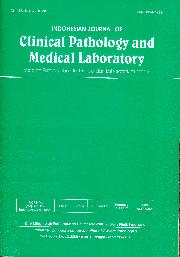Indonesian Journal of Clinical Pathology and Medical Laboratory
ISSN 0854-4263
Vol. 18 / No. 3 / Published : 2012-01
Related with : Scholar Yahoo! Bing
Original Article :
Cold agglutinins in a community acquired pneumonia patient
Author :
- Johanis*1
- J. Soemarsono*2
- Bag PK FK-UNAIR/RSU Dr. Soetomo Surabaya
- Bag PK FK-UNAIR/RSU Dr. Soetomo Surabaya
Abstract :
Cold agglutinins at below physiologic body temperature can cause spontaneous agglutinations of erythrocytes. Cold agglutinins result from a particular antibodies activation on erythrocytes associated with a primary disease, including infection. The generation of antibody activates complement resulting in hemolysis. A 63-year-old man suffered from shortness of breath accompanied with productive cough, fever, right chest pain, loss of appetite, nausea, and occasionally vomiting. Physical examination showed an increase of pulse rate, respiration rate, and body temperature. Lung examination showed right intercostals retraction and rales in both lungs, but no abnormality detected in other organs. Chest X-ray showed pneumonia. EDTA whole blood showed spontaneous agglutinations at room temperature, however this did not occur by maintaining temperature at 37°C. Different complete blood count results were shown between agglutinated blood and absent of agglutination blood samples. As anti-I, anti-i, and/or anti-H was suspected, agglutinations for anti-A and anti-AB occurred by using ABO forward grouping test, whereas reverse grouping showed agglutinations for A, B, and O cells. Protein electrophoresis showed increase of alpha-1 and gamma globulin; decrease of renal function; slightly increase of indirect bilirubin; and suspected Extended Spectrum Beta-Lactamase (ESBL) Klebsiella pneumoniae. The diagnosis of this case was community acquired pneumonia and suspected ESBL. Cold agglutinins affected CBC evaluations mostly shown in the erithrocyte index, nevertheless this could prevented by maintaining at physiologic body temperature. Infection could induce activation of cold agglutinins. Aglutinin dingin (Cold agglutinin) menyebabkan pergumpalan (aglutinasi) sel darah merah (eritrosit) spontan yang terjadi di bawah suhu tubuh fisiologis. Cold agglutinin disebabkan oleh aktivasi antibodi tertentu terhadap sel darah merah akibat penyakit dasar, misalnya infeksi. Pembentukan antibodi mengaktifkan komplemen dan menyebabkan penguraian darah (hemolisis). Kasus ini menyajikan laporan seorang laki-laki berusia 63 tahun menderita sesak napas disertai batuk berdahak, demam, nyeri dada kanan, nafsu makan menurun, mual, dan kadang muntah. Pemeriksaan fisik didapatkan peningkatan denyut nadi, kekerapan napas, dan suhu badan. Pemeriksaan paru menunjukkan retraksi interkostal dekstra dan ronkhi bilateral, sedangkan periksaan organ lain dalam batas normal. Gambar rontgen dada menunjukkan radang jaringan paru (pneumonia). Pemeriksaan darah EDTA menunjukkan aglutinasi sel darah merah spontan pada suhu ruangan, tetapi aglutinasi dengan mempertahankan suhu 37°C tidak terjadi. Terdapat perbedaan hasil hitungan darah lengkap (complete blood count) antara aglutinasi sel darah merah dan darah tanpa keadaan tersebut. Kecurigaan terhadap anti-I, anti-i, dan atau anti-H diuji dengan pengelompokan depan (forward grouping) ABO yang menunjukkan aglutinasi di anti-A dan anti-AB, sedangkan uji pengelompokan sebaliknya (reverse grouping) menunjukkan aglutinasi di sel A, B, dan O. Elektroforesis protein menunjukkan peningkatan alfa-1 dan gamma globulin; penurunan fungsi ginjal; peningkatan ringan bilirubin tidak langsung; dan kecurigaan Beta-Laktamase berspektrum luas/Extended Spectrum Beta-Lactamase (ESBL) Klebsiella pneumoniae. Diagnosis klinis penderita adalah community acquired pneumonia dengan kecurigaan ESBL. Cold agglutinin mempengaruhi periksaan CBC terutama indeks sel darah merah, tetapi dapat dicegah dengan mempertahankan derajat suhu fisiologis tubuh. Infeksi mencetuskan aktivasi cold agglutinin.
Keyword :
Cold agglutinins, community acquired pneumonia, ESBL,
References :
Sheehan C,(1990) Clinical Immunology: Principles and Laboratory Diagnosis USA : J.B.Lippincott Company
McPherson R.A., Pincus W.R,(2006) Henry’s Clinical Diagnosis and Management by Laboratory Methods USA : Saunders Elsevier
Harmening D.M,(1999) Modern Blood Banking and Transfusion Practices Thailand : Promotion and Service Cp., Ltd
Harper J.L,(2010) Cold Agglutinin Disease http://emedicine.medscape.com/article/954954-overview : eMedicine from WebMD
5. Fauci A.S., Braunwald E., Isselbacher K.J., Wilson J.D., Martin J.B., Kasper D.L., Hauser S.L., L,(1998) Harrison’s Principles of Internal Medicine USA : McGraw-Hill
Archive Article
| Cover Media | Content |
|---|---|
 Volume : 18 / No. : 3 / Pub. : 2012-01 |
|












